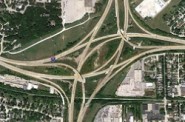Want to spend less than $4,200 a year on gas?
According to the Oil Price Information Service the average U.S. family spent $4,200 on gasoline in 2011. To put it in perspective, with that much money you could buy eight iPad 2s, or eight Trek 7.1 FX bicycles, or you might even purchase one expensive cruise to Dubai to see what your gas money is building.
What if you could cut your spending on gas substantially. Would you? Could you?
Here’s how:
The primary method to reduce spending on gasoline is to live in a dense walkable neighborhood that has shops and services within walking distance. Due to the degree of job sprawl that has occurred in the U.S. it might be difficult for your family to live, work, and play all in the same neighborhood, but living in a walkable neighborhood will still significantly reduce the need to drive because you will be able to replace some vehicle trips with walking trips. For example, the ability to replace a three mile drive to the grocery store with a two block walk to the store is possible in a walkable neighborhood, but generally not possible in suburbia. And it is the replacement of these additional trips, not just the commute to work, that can add up to substantial savings.
Finally, to save money and cut down on trips to the gas station, you can use mass transit to replace automobile trips. One year of bus rides on the Milwaukee County Transit System only costs $768. Despite years of service cuts and fare increases, taking the bus for a variety of trips, be it commuting or just getting around, is still possible on MCTS and is still a great way to drive less and save more.
You and your family may not be able to go car-free, but quite simply to save on your gas bill live in a walkable neighborhood, ride a bike, and catch the bus.
Car Culture
-
It’s PARK(ing) Day, Let the Celebration Begin
 Sep 20th, 2013 by Jeramey Jannene
Sep 20th, 2013 by Jeramey Jannene
-
Why WisDOT Is Behind the Times
 Jun 12th, 2013 by Dave Reid
Jun 12th, 2013 by Dave Reid
-
Walker’s Massive Borrowing Scheme
 Feb 19th, 2013 by Dave Reid
Feb 19th, 2013 by Dave Reid























My family and I did just this: we were living in suburban St. Louis and were driving 30-50 min to work every day and 20 minutes to do routine shopping (groceries, target, big box stores). We thought that this was just how things worked if you wanted to avoid crime and bad schools. After a trip to Europe in 2007 we saw that a different way of living was possible. We could have a different life where we could walk or bike to everything, save money, and be fitter at the same time. We read several books/articles (like this one) on the subject. It took four years to overcome the the inertia, do the research, sell the house, find a job, find a new place, etc. but we finally made the move. Now we’re living in urban Madison and can walk, bike, or take the bus to pretty much everywhere we want to go. We went from two cars to one car (getting rid of a car payment in the process) and this has almost never been an issue. We *have* spent more money on bicycles and related accessories but those are just up front costs. We’ve been happier and have even shed several pounds since the move.
@Scott Thanks for the comment! Glad to hear it! And yeah I was just looking at the gas costs, but being able to drop one car represents a huge yearly savings as well.
While I like the idea of walkable, I don’t think the economic math works out. To have groceries, etc. within a couple of blocks in a city of this size would require a serious increase in the number of shops, which in turn increases the fixed costs of doing business, which in turn would increase prices, so you save on gas, but spend on food. Not sure whee the break even point would lie, if there even is one. It’s a sad fact that the mega marts were created because they enabled cheaper food distribution, essentially off-loading to the consumer some of the costs of the “last mile” storage and distribution.
Arlen, that’s a bit of an abstract conclusion. I live within walking distance of multiple places where I can buy groceries, yet I can also reach big box retail relatively quickly. Now, are my costs lower or higher? If I have a greater number of options as to where I shop… is that better or worse?
Every business has to find their niche… that’s why you don’t see a corner store opening across the street from a Walmart/Target… there’s no point in paying for the convenience of the retail, when it’s already there. However, there are many many areas where it wouldn’t make sense to open a huge facility & a smaller “convenience store” can fill that void.
Dave and Jesse, I agree with what you’re saying, and am generally a proponent of the urban lifestyle. However, keep in mind that depending on the alternative locations that you are comparing, a large portion of the money that you could save on gas by not having to drive could be taken away by the higher cost of living in a denser area (comparing similarly-sized units with similar amenities). Not trying to be nit-picky, but it’s a relative cost.
Hi Peter, my cost of living in the city of Milwaukee wouldn’t differ remarkebly from my cost of living in Germantown (MKE suburb). In a metro of Milwaukee’s size, it comes down to personal choices rather than cost of living differences. In this marginal accounting it’s where I come ahead by not having to own/operate/maintain/depreciate a 2nd car.
There can come a point, depending on the location, where it wouldn’t save me money to live in a more urban area. But you know what, it was never solely about finding the cheapest place to live.
Do you eat plain white rice every night for dinner because it saves you money?
Jesse,
I agree, it’s really a quality-of-life choice. I was just making the point that people generally don’t live in a more urban area for the cost savings (correct me if I’m wrong), but the benefits that you do get for living in a denser area we would argue make up for likely paying a little more overall.
Peter, I see what you’re getting at now… I def agree it’s not a strictly quanitative($) choice instead of a more nuanced qualitative. Either way, less $ into cars & their maintenance is more into the local economy.
Cheers,
– Jesse
@Peter + Jesse Recently the Center for Neighborhood Technology has done some research into this topic, and when you put housing and transportation together into a true affordability index it shows that more often than not the walkable neighborhood is actually more affordable as a percentage of income than sprawl…
http://htaindex.cnt.org/mapping_tool.php#region=Milwaukee–Waukesha%2C%20WI&theme_menu=0&layer1=23&layer2=24
Dave, wow that is really cool to see. To be honest, I like promoting the urban lifestyle, but it’s often hard to do without factual evidence like this. Thanks for posting.